STE Highlights, April 2021
Awards and Recognition
Earth and Environmental Sciences
‘Fracture caging’ unveiled as a new method to prevent human-induced earthquakes
Materials Science and Technology
Role of ion sputtering examined in quest to develop atomic resolution images of plutonium
Theoretical
Los Alamos makes foundation contributions to Electron-Ion Collider physics, detector studies
Awards and Recognition
Chung Hyuk Lee awarded NSERC fellowship
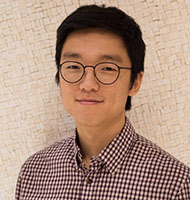
Chung Hyuk Lee (Materials Synthesis and Integrated Devices, MPA-11) has been awarded a Natural Sciences and Engineering Research Council of Canada (NSERC) Postdoctoral Fellowship. NSERC is a federal research funding agency mandated to promote and support postsecondary-based research and training in the natural sciences and engineering. The fellowship program provides support to promising researchers at a pivotal time in their careers and is intended to secure a supply of highly qualified Canadians with leading-edge scientific and research skills for Canadian industry, government, and academic institutions. Fellowship recipients are selected based on their research ability and potential and communication, interpersonal and leadership abilities. Lee, who earned his PhD in mechanical engineering from the University of Toronto, is a postdoctoral researcher on MPA-11’s Fuel Cells and Electrochem Sensors Team. His mentor is Jacob Spendelow.
Nora Norvell wins UC-National Lab In-Residence Graduate Fellowship
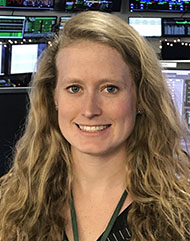
Nora Norvell, a graduate student in accelerator physics at UCSC, has won the 2021 UC-National Lab In-Residence Graduate Fellowship to work at LANL as part of her graduate program. She will work with Rod McCrady and John Smedley (Accelerators and Electrodynamics, AOT-AE) to develop a new diagnostic for the Isotope Production Facility (IPF), the Submergible Wireless Imaging Monitor. The device has the potential to allow tuning to be performed in minutes rather than hours, thus increasing potential production capability of the IPF. Norvell has experience as an accelerator operator at the Linac Coherent Light Source and is focused on operations physics, especially at large national facilities. This program benefits from and builds upon Jen Bohon’s (Advanced Sources Detector Project Office, ASD-PO) UCFees program to develop advanced accelerator diagnostics.
Chemistry
Properties of boron investigated
Two Los Alamos postdocs in Chemistry Division, Shelbie Legett and Samantha Talley in the Chemical Diagnostics and Engineering (CDE) group, are each investigating the properties of boron, from its life-giving properties to its potential life-saving properties.
Legett and Talley both gave short talks on their science for LANL’s “Science in 3” postdoc competition in fall 2020. Both presentations can be viewed here.
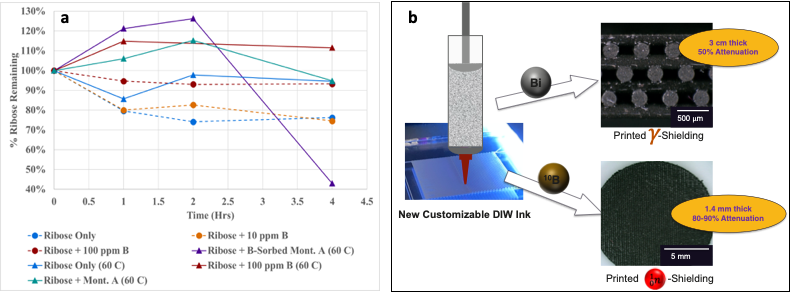
Left: Ribose remaining in pH 10 solution throughout experiments based on changes in ribose GC-MS peak areas. Dashed lines represent experiments performed at room temperature, and solid lines represent experiments performed at 60 °C. Right: Flexible AM radiation shielding materials printed with ink containing high loadings of elemental bismuth and boron-10.
Legett's research, “Exploring how boron + clays can stabilize ribose under prebiotic Earth/Mars conditions,” seeks to answer questions about the origin of life on Earth and the possible early life origins on Mars by examining on how ribose can be stabilized in a prebiotic solution, such that it can go on to form RNA. Specifically, Legett and colleagues have been studying the potential for a stable borate-ribose-clay complex to have existed under prebiotic Earth and Mars conditions. Thus far, experiments have confirmed that adding borate to a ribose solution significantly slows the degradation of ribose and have suggested that borate-sorbed clay minerals may remove ribose from solution to concentrate on clay surfaces (see left figure).
This work supports the Lab’s science and engineering capabilities and the Science of Signatures Pillar. Funding comes from the Laboratory Directed Research and Development Program (LDRD).
Talley's research, “Just Print It! Developing Customizable 3D-Printed Radiation Shielding,” aims to develop composite elastomer formulations with applications for flexible additively manufactured (AM) radiation shielding. Her team has demonstrated prototype radiation shields composed of very high loadings of Bismuth and Boron-10 for gamma and neutron shielding, respectively (see right figure). Despite solid filler content greater than 60 wt.%, these customized AM shields remain flexible and compliant, suitable for a variety of radiation applications with a broad range of radiation signatures.
Talley’s work supports Materials for the Future Pillar, and the Lab's Global Security mission. Funding comes from Science campaign (C2).
Technical Contacts: Shelbie Legett and Samantha Talley
Earth and Environmental Sciences
‘Fracture caging’ unveiled as a new method to prevent human-induced earthquakes
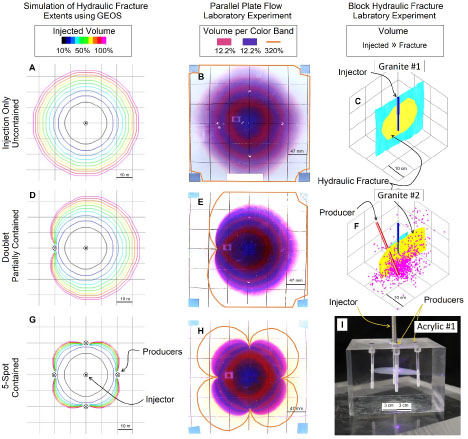
Images show results of the demonstration of fracture caging versus conventional single and doublet well designs. Numerical models, plate flow experiments, and rock fracture tests all confirm the ability of a well cage to halt new fracture growth and intercept high-pressure flowing fluids before they leak into the surroundings. Before the work, it was incorrectly believed that a small well could not halt a large fracture.
In a large collaboration, Earth and Environmental Sciences (EES) Division researchers discovered a new method to prevent human-induced earthquakes caused by injection and/or extraction wells. This method will help avoid a repeat of the disruption caused by saltwater disposal wells that induced seismicity in Oklahoma or the civil property damage caused by a geothermal well in Pohang, South Korea. The method enables safer and more sustainable development of subsurface energy resources at higher efficiency than what was achievable using conventional methods.
The method, called fracture caging, involves drilling a small tactical pattern of wells around a subterranean resource such that any rock fractures that connect to injection wells will also intersect this cage. This cage prevents the escape of injected fluids into the surrounding environment, thereby preventing induced earthquakes and environmental contamination. A key component of caging is to directly consider the complex, dynamic, and unpredictable nature of localized fluid flow in fracture dominated rocks, rather than attempt to treat the system as a simplified porous media according to common practice.
Unlike conventional methods, caging permits high-pressure fluid injection at any rate or pressure while also preventing the large ground shakes. This offers a massive step change for increasing safe access to and reliable utilization of our nation’s largely untapped geothermal energy reserves and could be the key to unlocking more than 60 gigawatt-electric (GWe) of new geothermal energy production.
The Los Alamos team collaborated with eight national laboratories, four industrial partners, and seven universities to spearhead the fracture caging concept. The team completed the first laboratory tests that successfully demonstrated the concept in a variety of natural rocks and engineered materials.
In 2017, the Department of Energy’s Geothermal Technologies Office (GTO) funded national laboratories to focus on GTO’s vision for longer-term, transformational enhanced geothermal systems (EGS), establishing a collaborative experimental and model comparison initiative: the EGS Collab. As part of the most recent phase of the EGS Collab project, a decameter scale test is now underway at the Sanford Underground Research Laboratory that aims to use fracture caging to study fracture and flow processes deep in the earth.
The team published its results in Geophysical Research Letters.
Funding and Mission
This research was funded by the Department of Energy’s Office of Science Basic Energy Sciences Program (LANLE3W1). The EGS Collab work in this study is supported by the U.S. Department of Energy, Office of Energy Efficiency and Renewable Energy (EERE), Geothermal Technologies Office (GTO) under Contract No. 89233218CNA000001 with Los Alamos National Laboratory, led by Contract No. DEAC02-05CH11231 with Lawrence Berkeley National Laboratory. Research supporting this work took place in whole or in part at the Sanford Underground Research Facility in Lead, South Dakota. The assistance of the Sanford Underground Research Facility and its personnel in providing physical access and general logistical and technical support is gratefully acknowledged. This work supports LANL’s new Complex Natural and Engineered Systems (CNES) pillar and the Lab’s energy security mission.
References
Frash, L.P., Fu, P., Morris, J., Gutierrez, M., Neupane, G., Hampton, J., Welch, N.J., Carey, J.W., Kneafsey, T., “Fracture caging to limit induced seismicity,” Geophysical Research Letters (2020). https://doi.org/10.1029/2020GL090648.
Frash, L.P. “Fracture caging to control earthquake magnitude from induced seismicity: preventing a repeat of Pohang” Paper presented at the 54th U.S. Rock Mechanics/Geomechanics Symposium (physical event cancelled), June (2020). ARMA-2020-1716.
High Performance Computing
LANL-developed software addresses the world’s data storage crisis
Data storage is a problem, and it’s growing. Right now, warehouses the size of several football fields are used around the world to store data on hard drives, and in the U.S. alone storage centers account for nearly 2 percent of the country’s electricity consumption. Soon, the world will generate more digital data than it can store.
Scientists are asking how more data can be stored in less space, and Los Alamos researchers have turned to nature’s storage strategy—DNA—as the solution.
“Our Adaptive DNA Storage Codex, or ADS Codex, translates data in binary to nucleotides that make up DNA, and back again,” said Latchesar Ionkov of HPC Environments (HPC-ENV). “Just like you can translate English to French, ADS CODEX can translate between binary and DNA.”
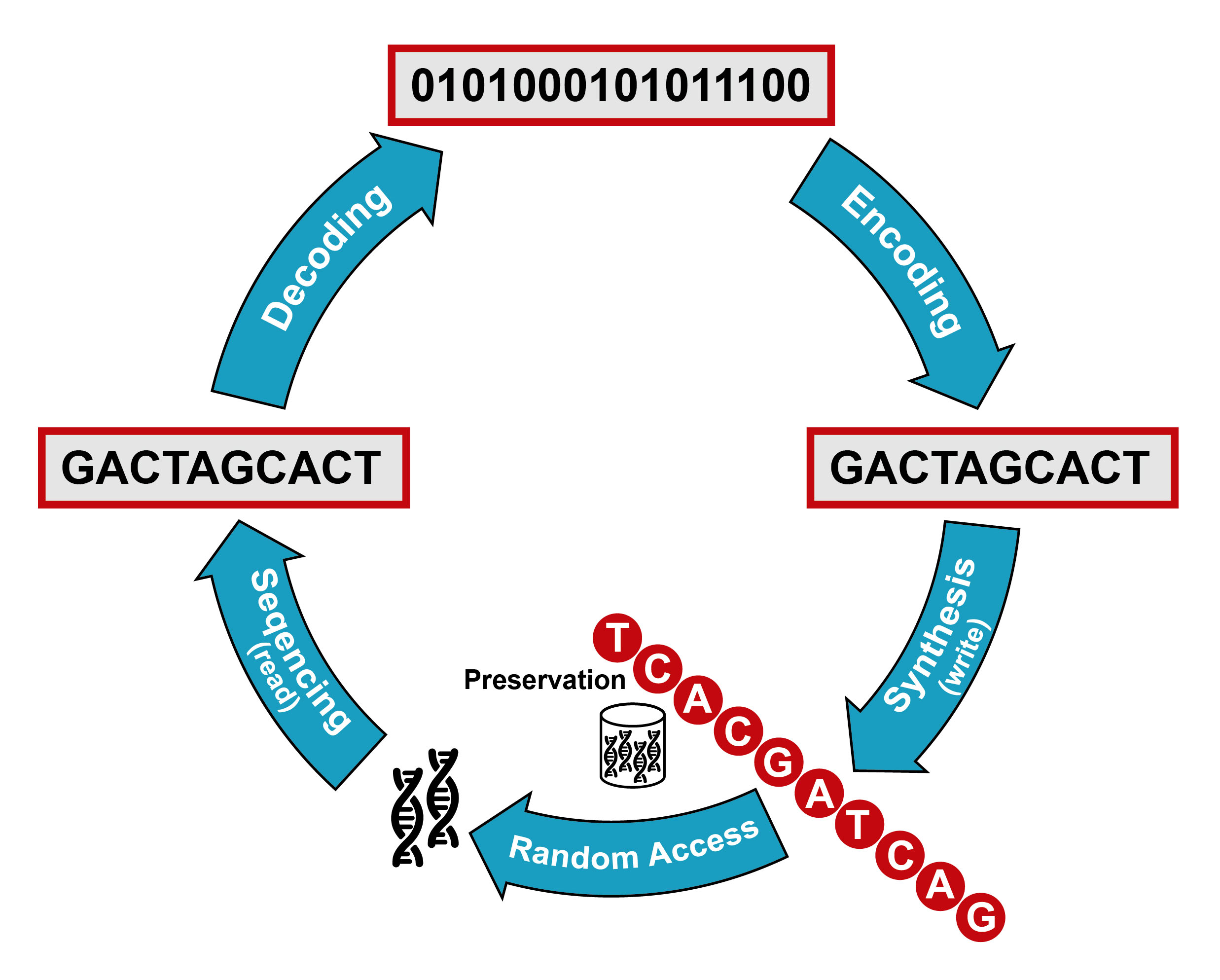
An illustration demonstrating using DNA as physical media in a molecular information storage system.
ADS Codex is the open-source software tool that acts as the translator between the two languages—binary and nucleotides. However, there are physical steps to the process as well. Los Alamos bioscientist Tracy Erkkila of Biosecurity and Public Health (B-10) aids in the specialized DNA sequencing and synthesis.
The act of turning digital data into physical storage is the same in the scenario of hard drives in storage centers as DNA in laboratories. The difference is in how much space that physical storage takes up and how long that storage type can last.
For DNA, 10,000 gigabytes of data can be stored in a single smear of DNA. Samples of DNA have been stored and sequenced 500,000 years after they were created. Those are significantly better parameters than what hard drives and magnetic tapes can offer, which is a lifetime well under 30 years.
These statistics have made DNA desirable as data storage for quite some time, but science hadn’t caught up until now. ADS Codex is the missing link that will universally convert digital data, such as a picture of a cat, into a coded double helix of DNA that can last for thousands of years. When you want to view that picture at any point in the future, ADS Codex can translate the DNA sequence back into binary, preserving all of the features as a perfect photo. It was this translation that was the obstacle, and ADS Codex can accommodate translation on a large scale.
ADS Codex is open source, available to anyone for free. It offers the highest data density (1.94 bits/nucleotides) of any platform on the market, and it is the only platform that can correct metadata errors due to natural DNA insertions and deletions.
ADS Codex couldn’t have come at a better time, given that global data storage demand is expected to grow to 175 zettabytes within the next few years. That is an astonishing amount of data that includes every cat picture you share as well as terabytes of New York Stock Exchange trades, large-scale cancer simulations, and essentially everything run on supercomputers. Hard drives won’t be able to keep up in the very near future.
Funding and mission
ADS Codex is sponsored by Intelligence Advanced Research Project Agency (IARPA). The work supports the Laboratory’s Global Security mission area and the Integrating Information, Science, and Technology for Prediction capability pillar.
References:
ADS Codex GitHub download page
Learn more about Molecular Information Storage at IARPA
Technical contact: Latchesar Ionkov
Materials Physics and Applications
A new approach toward high quality epitaxial actinide thin films
Technique benefits fundamental understanding and theoretical modeling of nuclear materials
For the first time ever, Los Alamos researchers working in collaboration with external researchers have synthesized high-quality epitaxial UO2, U3O8, and UO3 thin films using pulsed laser deposition (PLD). Once fabricated, the films’ functional properties were explored via a variety of spectroscopy techniques.
Uranium oxides have been considered as the most interesting actinide oxides because of their intriguing physical properties and technological significance in nuclear energy applications. In particular, advancing the growth processes of uranium oxides will open new routes to develop novel correlated materials for future energy, sensing, and other applications. Given this technological significance and the rich physical and chemical properties of the UOx material system, exploring the growth of high quality epitaxial UOx films with desired crystal structures and polymorphic phases is imperative.
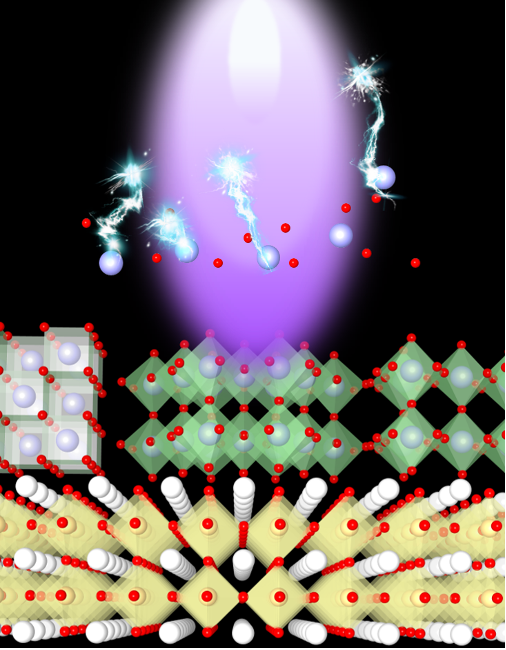
The illustration depicts the formation of different phases of epitaxial UOx thin films (middle region) by atoms in the plasma (purple oval) generated during the laser ablation on single crystal substrates (bottom).
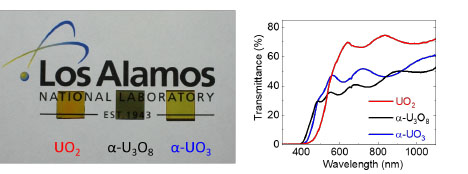
(Left) Photographs of epitaxial thin films grown by the PLD. (Right) Transmittance spectrum for epitaxial thin films.
In work appearing in ACS Applied Materials and Interfaces, the researchers describe the successful use of PLD to grow three different types of UOx thin films and explore the structural and optical properties. This production capability opens new avenues to explore applications and properties of a variety of actinide thin films.
The team systematically optimized the processing conditions for the epitaxial growth of the films with a high degree of control over both the phase and the structure. The crystal structures and chemical valance states of the UOx films were confirmed by Raman spectroscopy and x-ray photoelectron spectroscopy. The optical properties of these films are investigated by ultraviolet-visible spectroscopy. Additionally, the lattice vibrational modes of epitaxial UOx films from Raman spectra were in good agreement with the density functional theory calculations.
The work leverages the Laboratory’s capabilities and expertise in thin film growth and characterization and materials modeling and simulation.
The work, which supports the Lab’s Energy Security mission and its Materials for the Future science pillar, was performed in part at CINT, a DOE Office of Science Basic Energy Sciences user facility jointly operated by Los Alamos and Sandia national laboratories. The Los Alamos portion of the work was funded by the Laboratory Directed Research and Development (LDRD) program, with partial support from the Lab’s G.T. Seaborg Institute.
Researchers: Aiping Chen, Erik Enriquez, Yogesh Sharma, Ibrahim Sarpkaya, Nicholas Winner, Paul Dowden, Han Htoon (Center for Integrated Nanotechnologies, MPA-CINT); Gaoxue Wang, Ping Yang, Enrique Batista (Physics and Chemistry of Materials, T-1); John Dunwoody, Joshua White, Andrew Nelson (Materials Science in Radiation and Dynamics Extremes, MST-8); and Hongwu Xu (Earth System Observations, EES-14).
Reference: “Structural and optical properties of phase-pure UO2, α‑U3O8, and α‑UO3 epitaxial thin films grown by pulsed laser deposition,” ACS Appl. Mater. Interfaces 12, 35232−35241 (2020). https://doi.org/10.1021/acsami.0c08635
Technical contact: Aiping Chen
Materials Science and Technology
Role of ion sputtering examined in quest to develop atomic resolution images of plutonium
Actinide scientists broadly regard plutonium (Pu) as the most complex element in the periodic table. Its reactivity, radioactivity, and toxicity make plutonium intriguing—yet challenging—to analyze.
With the aim of characterizing Pu surfaces with high spatial resolution, Los Alamos developed a first-of-its-kind scanning tunneling microscopy (STM) capability for plutonium housed in an ultra-high vacuum (UHV) system. Despite the tool’s ability to produce atomic resolution images of well-known standards, achieving such resolution for Pu sample surfaces has been prevented by the difficult challenge of producing a suitable Pu surface.
Sputtering is a well-established method of preparing Pu surfaces under UHV conditions for analysis. However, no studies have addressed the effects of this method on the surface roughness of Pu. Although it is well known that sputtering of a sample surface can result in damage and roughening, when combined with annealing in certain materials under the right conditions, sputtering can result in atomically clean, smooth, and defect-free surfaces.
As part of an effort to produce Pu surfaces of the quality needed for atomic resolution STM imaging, Los Alamos researchers investigated the effects of argon-ion sputtering and subsequent annealing on the surface roughness of Pu samples. According to Miles Beaux, who led the effort to establish the capability, “Direct observation of the radioactive decay of a single atom using STM was proposed in 2003 by Alexander V. Balatsky and Jian Xin Zhu (Real Time Imaging of the Radioactive Decay Damage with Scanning Probe Microsopy). The establishment of a plutonium capable STM is an opportunity to reach this objective.”
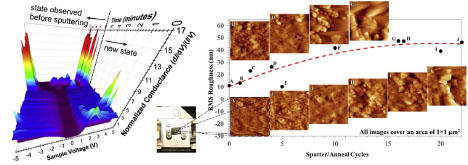
A picture of the plutonium sample is shown (center) along with microscope images (right) of the sample surface. The spectral graph (left) demonstrates the dynamically changing electronic structure of the plutonium surface over 10 minutes after the first sputter treatment. Left: Scanning tunneling spectra collected over a 10-minute duration from a location within a 0.5 by 0.5 nm2 area on the same electropolished Pu sample after the first sputter/anneal treatment. Right: Scanning tunneling microscopy (STM) images of the electropolished Pu sample with the root mean square roughness values for each image plotted as a function of sputter/anneal cycles.
Their research revealed that such sputtering/annealing cycles progressively increased the surface roughness of the Pu. Additionally, Auger and STM measurements revealed an initially unstable and dynamically changing surface that became increasingly stable as sputter/anneal cycles were applied. They observed that the stabilized surface region contained within the sputter crater was observed to be unchanged for up to 17 months after the final sputter anneal cycle. This was surprising since it was assumed that under UHV conditions, the material would revert back to its pretreated state.
The work was performed in the Plutonium Surface Science Laboratory, which is operated as a collaboration between Engineered Materials (MST-7) and Nuclear Materials Science (MST-16). The research, which supports the Laboratory’s Nuclear Deterrence mission area and the Materials for the Future capability pillar, was funded by the Lab’s Science Campaign 1.
Reference: “Effects of ion sputtering on plutonium surfaces,” Journal of Nuclear Materials 540, 152378 (2020). https://doi.org/10.1016/j.jnucmat.2020.152378
Researchers: Miles Beaux, Igor Usov (Engineered Materials, MST-7) and Stephen Joyce (Physical Chemistry and Applied Spectroscopy, C-PCS). Samples used in this work were provided by Nuclear Materials Science (MST-16).
Technical contact: Miles Beaux
Improving how metals withstand nuclear reactions
Researchers from the Texas A&M University Department of Materials Science and Engineering and Los Alamos National Laboratory (LANL) Materials Science in Radiation and Dynamics Extremes (MST-8) are improving the metals used to construct nuclear technology. This collaboration is made possible by The Texas A&M University System National Laboratories Office and Los Alamos.
Michael Demkowicz and Kelvin Xie from Texas A&M and Yongqiang Wang of Materials Science in Radiation & Dynamics Extremes (MST-8) are investigating hydrogen retention in metals that are exposed to nuclear processes, with the intent of improving how these materials perform over time.
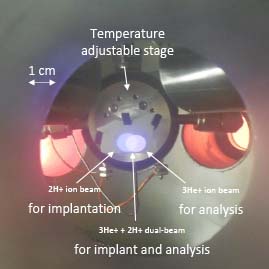
IBML’s dual-beam chamber between 3 MV NEC tandem accelerator and 200 kV Varian ion implanter to be used to perform H-implantation and H-retention measurement with nuclear reaction analysis, 2H(3He, p)4He.
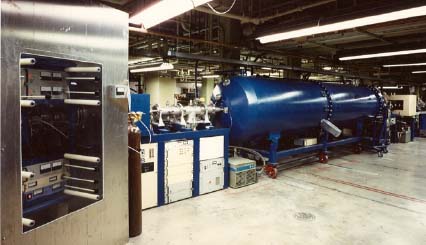
3 MV Tandem Ion Accelerator where hydrogen retention measurement is done using nuclear reaction analysis.
Hydrogen retention in metals is a serious concern in nuclear technology. Nuclear reactions and transmutations by reactor neutrons cause changes to chemical elements and isotopes, thus introducing additional hydrogen into materials. Often hydrogen accumulates to levels that exceed the solubility limit a material can absorb. The excess of hydrogen in the material causes brittleness and weakness, limiting its functionality over time.
Another issue with excess hydrogen is that it accumulates at trapping sites, such as in spaces in the material and at grain boundaries. Most metal alloys are actually made up of lots of microscopic crystals packed closely together. These little crystals are called “grains” and the planes where adjacent grains are fused together are called “grain boundaries.” Under reactor environment, the defects created by irradiation processes such as vacancies and dislocations also become new traps for hydrogen. When many hydrogen atoms are trapped together, they form gas bubbles in the metal, similar to carbon dioxide bubbles in soda. These bubbles can facilitate the formation of large voids that can cause severe damage to the material.
Wang added, “One such prominent example is that neutron-irradiation enhanced tritium retention in plasma facing components becomes a key material challenge in magnetic confinement fusion devices since both the worker safety on tritium handling and limited tritium supply in the world require advanced plasma facing materials.”
One way to manage the hydrogen accumulation and subsequent damage is to remove as much of it as possible from the material. Unfortunately, most materials do not contain a good pathway through which hydrogen can travel. In this project, the researchers will create composites where pathways for hydrogen motion are built into the structure of the material.
Demkowicz explained, “The novel materials to be developed and tested as part of this project are expected to exhibit ‘self-healing’ behavior, whereby damage would be removed from the material even as it is created. This would be an outcome of their unique internal microstructures.”
In order to test the materials for hydrogen retention, diffusion and outgassing, the researchers will use the unique collection of ion implantation and ion beam analysis tools available at Los Alamos’s Ion Beam Materials Laboratory. These tools will allow the researchers to introduce and track the amount of hydrogen in the material with designer microstructures, thus providing data for the amount of hydrogen that is outgassed.
The ideal outcome for this project would be to identify composite materials that allow enough hydrogen outgassing to keep the retained hydrogen levels at or below their threshold. Such materials would be able to withstand nuclear reactions better than materials currently in use.
Demkowicz shared, “In addition to advancing basic science, this project will explore technical issues that are crucial to the development of future fusion reactors.”
Funding and mission
This work is supported by the TAMUS – LANL Collaborative Research Program. This work supports LANL’s Materials for the future capability pillar and the Lab’s energy security mission.
Theoretical
Los Alamos makes foundation contributions to Electron-Ion Collider physics, detector studies
A U.S.-based high-intensity Electron-Ion Collider (EIC) can uniquely address profound questions about nucleons — neutrons and protons — and how they are assembled to form the nuclei of atoms. The EIC will provide the ultimate microscope to determine the internal landscape of nucleons and nuclei, search for novel phenomena such as gluon saturation, answer long standing questions about how visible matter comes into existence, and investigate subatomic particle and energy transport through a strongly interacting quantum mechanical environment.
This next generation high energy nuclear physics facility received Mission Need approval (CD-0) by the U.S. Department of Energy in early 2020 and will be built at Brookhaven National Laboratory.
Los Alamos scientists made foundational contributions to the physics and detector studies at the EIC with special emphasis on the measurements of jets and heavy subatomic particles and on the design of tracking detectors in the forward proton or nucleus going region.
“This is an important milestone for LANL, as we are recognized leaders in the area of strong interaction physics. Our research in this field, for which we have received ample external and internal recognition, goes back to the early 1970s,” said Ivan Vitev, a senior scientist in the Theoretical division. “The EIC is an essential part of our long-term Laboratory strategy in Nuclear and Particle Physics, Astrophysics and Cosmology (NPAC).”
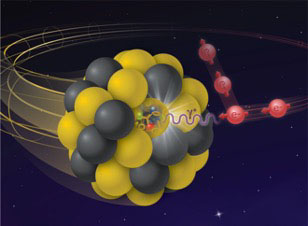
Electron-nucleus collisions probe the internal landscape of protons and nuclei. Illustration courtesy of Brookhaven National Laboratory.
To define the physics program of the EIC and the corresponding detector requirements, the international high energy and nuclear physics communities engaged in a year-long process to produce a document that charts the future of strong-interactions physics at the new facility. Released earlier this year in ArXiv, the 900-page EIC Yellow Report is co-authored by more than 400 researchers from 150 institutions worldwide. A fascinating feature of the theory of strong interactions — Quantum Chromodynamics (QCD) — is that the most fundamental constituents of matter, quarks and gluons, cannot be seen in isolation. Data from the HERMES Collaboration in the early 2000s showed pronounced differences in the rate of hadron production in electron-nucleus versus electron-proton collisions, has deepened the mystery of how the elementary particles that fill the universe come into existence, a process known as hadronization.
Recently, LANL researchers demonstrated that measurements of particles containing heavy quarks at the EIC, such as D-mesons, B-mesons, and quarkonia that were not accessible to HERMES, will provide precise information on the space-time picture of hadronization in an important breakthrough that can differentiate between competing theoretical paradigms. The team further showed that such particles can be reconstructed with excellent statistics with state-of-the-art silicon tracking detectors at the EIC. Another class of observables that the team investigated with external collaborators are called angularities and describe the shape of the collisions event. The angularity variables carry the promise to perform the most stringent tests of QCD and to constrain the strength of fundamental interactions in nature.
“The next step is to form collaborations and respond to EIC Center call for detector proposals. At this time, the LDRD-sponsored work at LANL has allowed us to play a key role in two emerging proposals,” said LANL’s Physics Division Xuan Li, who leads the experimental EIC effort at Los Alamos. Fast (sub-nanosecond), high spatial resolution (10-5-meter scale), and radiation hard silicon detector technology R&D for the EIC can also benefit in the future dynamic imaging of materials for applied campaigns at Los Alamos.
Funding and mission
This research was funded by a LANL LDRD grant, including a Directed Research and Director’s Fellowship Awards and a DOE Early Career award. The work supports the Laboratory’s Nuclear Deterrence mission area and the Nuclear and Particle Futures capability pillar.
Reference: R. Abdhul-Khalek et al., “Science Requirements and Detector Concepts for the Electron-Ion Collider: EIC Yellow Report,” ArXiv:2103.05419, LA-UR-21-20953 (Submitted March 2021). LANL co-authors include C. da Silva, M. Durham, C. Lee, X. Li, M. X. Liu, A. Morreale, I. Vitev, C. P. Wong. https://arxiv.org/abs/2103.05419
Technical contact: Ivan Vitev







